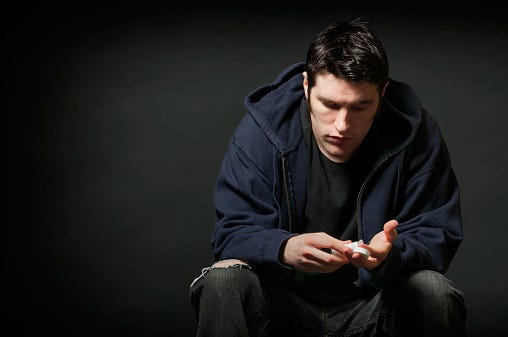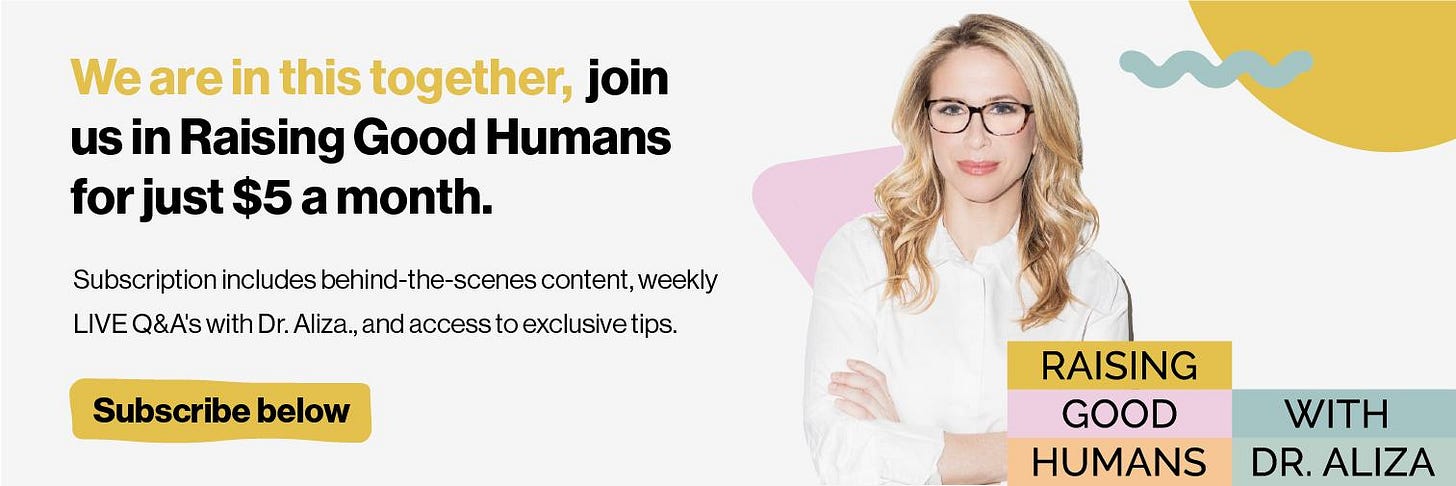Welcome to Raising Good Humans on Bulletin. We are so happy you're joining our judgment-free, science-backed parenting community. Subscribe now to get these articles in your inbox every week, AND consider becoming a premium member for exclusive behind-the-scenes access, LIVE Q&A's, and more original content.
Part 2 of my conversation with Dr. Dolly Klock on the Raising Good Humans Podcast left much to discuss.
I wanted to make sure that I organized some of the key take-aways. As I mentioned in the episode, this isn’t just one conversation, it is conversations over time.
Use this as a guide to start having small conversations with your adolescents, and remember (whenever you can) to lead with curiosity, and let them teach you about their experiences.
In this current culture, I want to help you feel more prepared knowing that our kids now have access to so much more than we did, and still trust that they're still growing and developing appropriately. Part of that is acknowledging to them, as well as yourself, that while they are going to push the envelope of what makes you feel comfortable, you are still going to be right there, making sure that the guardrails are strong enough to keep them safe.
Understanding the Source of Substances:
Even if you accept that your teens will likely try some substances at some point - nicotine, alcohol and cannabis being the most common - where they get it from is a new source of stress for parents. Social media channels have made it much easier for teens to order-up prescription medications that have the potential to be counterfeit and subsequently laced with Fentanyl.
What is Fentanyl? Fentanyl is a synthetic opioid that is 50x stronger than heroin and 100x stronger than morphine. In the past few years, drug dealers have been increasingly mixing Fentanyl into the drug supply to increase addiction and build customers, but this comes with an incredible risk. In a recent DEA analysis, 1 in 5 counterfeit pills had a lethal dose of Fentanyl in it. One pill can actually kill. Between 2019 and 2021, Fentanyl deaths in teens tripled, and 77% of all overdose deaths in teens were from Fentanyl. Most cases involved teens trying to purchase another prescription drug - like Xanax, Percocet, Adderall, or Oxycodin - and receiving a counterfeit pill laced with Fentanyl that looked, smelled, and was indistinguishable from the real pill.
What Can We Do?
Talking to our teens about this risk, asking them if they have heard of Fentanyl or know anything about it, is a great place to start. For example, tell them you just heard a podcast episode on this, and ask them to teach you what they already know. If they don’t know about Fentanyl, learn together.
We can also think about preparing with access to Narcan. As Dr. Klock says, it is becoming an important tool in our safety kits, and more and more schools and organizations are advocating families to arm teens and young adults with Narcan to save the life of a friend who may be overdosing. This is obviously a discussion to have with your physician but this can be a starting point.
What is Narcan? Narcan is a reversal agent used as a nasal spray that can reverse the symptoms of an opioid overdose. If a person becomes unconscious and an overdose is suspected, a friend can administer Narcan and save their life.
We also need to take responsibility to dispose of prescription narcotics after we are done using them. If you have pain pills left over from the dentist, or a procedure you had, they need to be disposed of safely (and locked while you’re still using them).
Here are some tips from the FDA around safe disposal.
Find a take-back center in your neighborhood using the DEA locator. You can drop unused medications at these locations for safe disposal.
For home disposal, avoid flushing medication down the toilet or throwing it as-is into the garbage. Instead:
Remove the pills from the bottle. Place them in a storage bag, along with coffee grounds, dirt or cat litter. These make the medications less desirable for pets or children to get to, and unrecognizable to those who may be going through trash looking for drugs.
Seal the storage bag and place it in the regular trash.
Remove your label from the prescription bottle, eliminating all identifying information and prescription information. Dispose of the label and the bottle separately.
How to have these tricky conversations with our teens?
Deal with your own reaction first. It is normal for parents to have a stress response to these topics, and to the very real fears and anxieties that come up. Take time to prepare by first talking with your partner, your friends, or your therapist. Plan and practice what you will say, and make sure to arrive at the conversation as regulated as possible. We don’t want our children to avoid talking to us about these issues because they are worried about our nervous system. We want them to know that we can take it, we can help them manage it, and that we are approachable around these topics.
Set realistic expectations for yourself as your child grows. Are you trying to prevent your child from ever leaving the house? Ever using any substances, or using substances safely? These may change over time. Gain clarity in each phase with what your expectations are, the environment in which we all live, and the child you are parenting.
Have small conversations over time. Maybe it is sparked by something you’re reading, or watching together. Ask about friends or characters so that the pressure is off your teen, and take one small subject at a time. Remember that you are working to keep the door open, not shove the couch through it in one push. Your connection with your teen is key to their safety. Staying connected in your relationship will make these discussions more natural, and more regular.
Try to avoid making it about fear or punishment. Though it can feel satisfying to YOU to scare your children into compliance with harsh threats or punishments, it often does nothing to change behavior. Fear usually makes teens go deeper underground, get sneakier about their behavior, and further away from a meaningful connection with you. Think about establishing safe guardrails that are based on WHO your child is, what they have done before, are doing now, and what feels comfortable for both of you.
Find ways to take safe risks for kids who need it. Acknowledging that you have a risk-taking, thrill-seeking, teen means that you can help them to find safe ways to get that high. Maybe it is skydiving, skiing, or rock climbing - find ways to promote that rush without substance use, and talk about how they can do this for themselves in healthier ways, like exercise.
Honor risk-averse kids with the opportunity to prove themselves. Finding ways to celebrate a teen who can opt out of substance use, doesn’t mean that you have to prevent them from ever attending parties. Instead, you can talk to them about how they are able to handle their own anxiety around substances while others make different choices. This can be an area where they can show you how responsible they are.
Get interested in their lives. Find points of connection with your teen around things they love. Make an effort to let them teach you, and sacrifice some of your own interests to help find moments where you can join them in their passions.
Stay connected to your community. For parents, we’ve experienced tremendous loss in this pandemic. We no longer had casual conversations with other parents, or with members of our community, at drop-offs, or sports games. We’ve gotten used to staying in the car, multitasking on Zoom, and being somewhat disconnected from our community. Use this as a call to action to get out of the car the next time you go to an event with your teen. Look up from your phone (I am so guilty of this!) when you can, and talk to the parent next to you. Finding your own community of parents can help to keep all of our children safer.
I’m grateful you’re in this community with me, and I look forward to more conversations together.
Thanks for being a part of Raising Good Humans. We are in this together.





